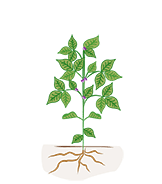
Soybean is the most important vegetable source of oil and protein for food use worldwide. Before the Second World War, China, Manchuria, Korea, and Japan were the countries most affected by its cultivation. In the United States, during the aforementioned conflict, there was a significant increase in the cultivated area following a government program aimed at obtaining a greater production of vegetable oils whose interchange had become particularly difficult. The USA is today the most important soybean producer, followed by Brazil and Argentina. The interest in this crop is mainly due to the oil content of the seed (18-21%) and the protein content (38-41%). Soybean oil is used both as an inedible oil and as an edible oil; while the soybean extracted meal is used for human nutrition in strong competition with other high protein foods and is appreciated as a zootechnical concentrate. Soybean is a kind of ancient cultivation. It is mentioned in Chinese literature before 2838 BC, but it is believed that it was extensively cultivated in China as early as 5000 years BC. Much later it was known in the US, in the early 1800s, and then in Europe: soybean was imported to England in the early 1900s as a starch-free food for diabetics.
Soybean belongs to the legume family and all cultivated varieties to the species: Glycine max. It is a bushy, erect, rather leafy plant. The stems of almost all varieties are covered with thick silvery or brown hair. Most cultivars are over one and a half meters tall, branching mainly from low knots. The type of growth habit can be indeterminate, semi-determinate or determinate. In general, the determinate forms present in many Japanese, Korean and southern United States varieties adapt well to environments characterized by a long vegetative season, high temperatures, high soil fertility, while the indeterminate ones are more suitable for opposite environmental conditions. In indeterminate types, flowering occurs from the bottom up; while in the determined types the first flowers to open are the flowers located in the apical part. Determined plants generally have 5-8 nodes in the early cultivars and 12-14 in the later ones and are characterized by lower risks of lodging. The leaves are of different types, in addition to the cotyledonary ones there are two simple oval-shaped primary leaves and trifoliate leaves, almost always thickly covered with hair. As ripening approaches, the leaf color begins to turn yellow and generally the leaves fall off before the pods ripen. The flowers are typical of legumes, white or purple in color. The pods are small, straight, or slightly curved, covered with fuzz and tend to open when ripe. They have a color that varies from yellow, to numerous shades of gray, brown to almost black; commercial varieties contain 2-3 seeds. The shape of the seed changes with the variety, it can be spherical, flattened and elongated, and in most cases, it is round or elliptical. The color can be straw yellow, yellow-gray, green, brown, black or a combination of these colors.
The root system is composed of a main tap root from which the secondary roots branch off. The crop cycle develops through different phenological stages: stages of vegetative and reproductive development.
Stages of vegetative development: ranging from emergence, they include the development of single and trifoliate leaves, up to the development of n nodes of the stem.
Stages of Reproductive Development: these include flowering, pod development and ripening.
The climatic needs are about the same as for corn. The minimum growing temperature is around 4-6 ° C: a temperature of around 24-25 ° C seems to be the optimum for all varieties. Lower temperatures delay flowering. At the seedling stage and in the ripening stage, soybean is less sensitive than corn to temperature changes. It adapts to a wide range of soils, from clayey to highly organic ones. As a legume crop, if its cultivation is managed correctly, it can represent an important economic and agronomic resource. In fact, it is considered a crop that improves soil fertility. It increases the fertility of the soil leaving it in better fertility conditions from a physical (structure), microbiological (biodiversity) and chemical (symbiotic soybean bacteria fix nitrogen in the soil) standpoint.
Nitrogen nutrition represents one of the main processes of all the metabolic activity of the soybean plant and is normally carried out through two ways:
1) The absorption of nitrate through the root system
2) The fixation of atmospheric nitrogen by radical nodules
Nitrogen fixing is due to specific rhizobia bacteria (Bradyrhizobium japonicum) that penetrate the root hairs of the soybean giving rise to numerous nodules or tubercles which are the seat of nitrogen fixation. To ensure optimal nitrogen fixing, it is important that the soil has a good structure, that the environmental conditions are favorable for the development of the crop and that selected bacterial strains are used. The inoculation to the seed is performed on the seeds with microbial consortia also containing Bradyrhizobium japonicum, with the aim of having an initial advantage in the formation of root nodules as well as improving the emergence and development of roots. Moderate nitrogen inputs are recommended to stimulate growth in the early stages. The critical moment for nitrogen requirements occurs just before the start of flowering.
In order to obtain high productions, contributions of phosphorus and potassium are also required. Phosphorus favors the increase in the percentage of protein and the potassium content, while potassium increases the amount of oil. The need for phosphorus is relatively constant throughout the cycle, but the crop shows a peak of absorption during the early stages of seed formation. In the last phase of ripening, the phosphorus is translocated from the vegetative parts to the seed. The soybean plant absorbs more potassium than phosphorus. Potassium is absorbed throughout the growing season and about half of the total is localized in the seeds.

Sowing


Leaf development


Flowering



Fruit & Seed

Agricultural soil is a fundamental component of the agricultural ecosystem. The most widely recognized function of soil is its support for food production. It is the foundation for agriculture and the medium in which nearly all food-producing plants grow. Healthy soils supply the essential nutrients, water, oxygen and root support that our food-producing plants need to grow and flourish. Soils also serve as a buffer to protect delicate plant roots from drastic fluctuations in temperature. Furthermore, the soil also performs hidden and less evident functions called ecosystem services. Careful soil management is one essential element of sustainable agriculture and provides a valuable lever for climate regulation and a pathway for safeguarding ecosystem services and biodiversity. Hello Nature propose an integrated approach to keep agricultural soil alive and healthy applying sustainable solutions: organic fertilizers, vegetal derived plant biostimulants and beneficial microbials. These solutions act on two of the main indicators of soil health, organic matter and biodiversity.
Plants need the right combination of nutrients to live, grow and reproduce. When plants suffer from malnutrition, they show symptoms of being unhealthy. Too little or too much of any one nutrient can cause problems. Plant nutrients are naturally obtained by the roots from the soil. Thus, nutrients may be physically present in the soil, but not available to plants. A knowledge of soil pH, texture, and history can be very useful for predicting what nutrients may become deficient and if leaf application of fertilizers and biostimulants may be necessary to ensure the optimal growth and development rate. Yield and the quality are strongly linked to the supply of nutrients through fertilizers product. However, nowadays sustainable fertilization management is essential to increase the overall performance of cropping systems by providing economically optimum nourishment to the crop while minimizing nutrient losses and supporting agricultural system sustainability by increasing Nutrient Use Efficiency (NUE). Plant biostimulants represent a promising strategy to boost sustainable agricultural production thanks to their capacity of improving directly or indirectly nutrient use efficiency of crops especially under low nutrient availability.
All growers, conventional and organic, have an interest in gaining back the yield potential lost due to abiotic stresses. It’s proven that on the average, farmers can harvest only 50% of the yield potential. The yield gap can be caused by biotic and abiotic stresses with a stronger negative impact of abiotic stresses. In fact, abiotic stresses like heat, cold, salt, drought and flooding caused from 65 to 75% of the yield gap, while biotic stress only 25 to 35%. Our vegetal protein hydrolysates, containing Plant Stimulating Peptides (PSP) have been shown been shown to consistently help plants better recover from stress events by increasing antioxidant supply, stimulating antioxidant biosynthesis, and activating antioxidant defense enzymes. PSPs increase photosynthetic activity and improve the nutritional status in the shoot tissues leading to a higher crop performance.
Growers have also an interest in gaining back lost yield-potential from crop stress brought on by herbicide application. When a plant comes under significant stress from herbicide application, reactive oxygen species (ROS) levels can increase considerably and cause cellular damage. This damage can range from slight to severe, vary by type of herbicide used, and the symptoms may be visible for a few days or through the whole growing season. Regardless of how herbicide stress presents itself, a grower needs to mitigate it and get crops back in a positive growth pattern to realize its full yield potential. One proven option is to use vegetal peptide biostimulants, which have been shown to improve resistance to abiotic stress. Foliar applications of our vegetal protein hydrolysates, containing Plant Stimulating Peptides, significantly reduce stress induced by herbicide use on soybean and protect grower’s yield.







